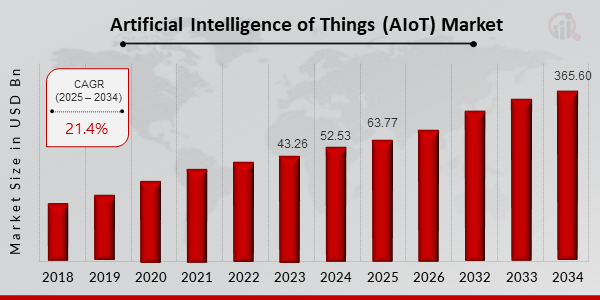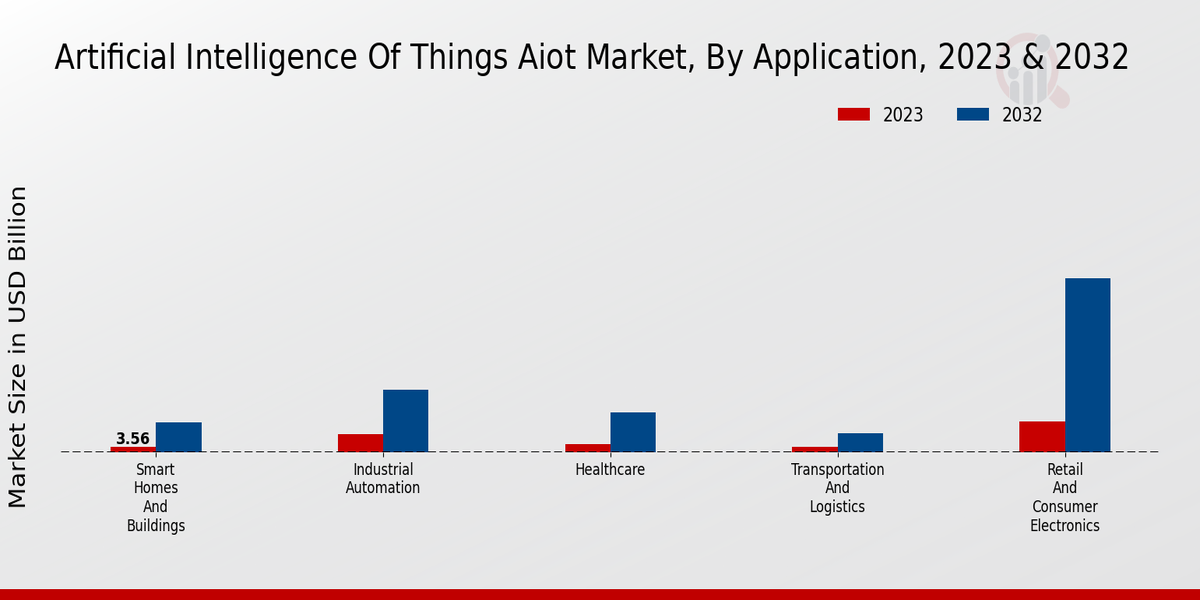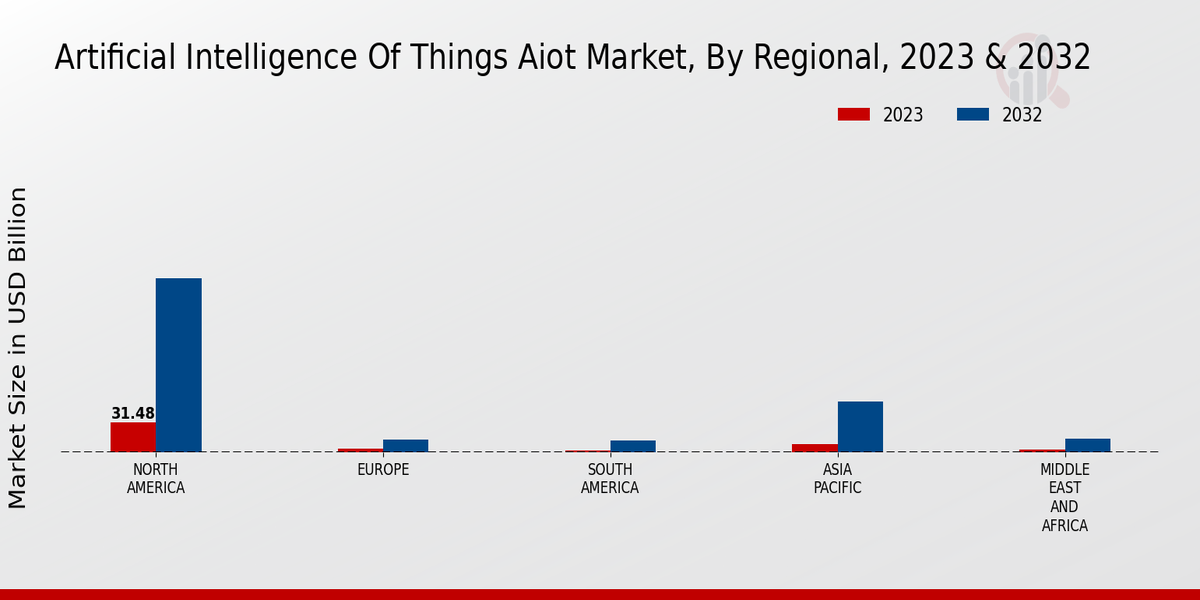Artificial Intelligence of Things (AIoT) Market Overview
Artificial Intelligence of Things Market is projected to grow from USD 63.77 billion in 2025 to USD 365.60 billion by 2034, exhibiting a compound annual growth rate (CAGR) of 21.41% during the forecast period (2025 - 2034).
Additionally, the market size for Artificial Intelligence of Things Market was valued at USD 52.52 billion in 2024.
Key Artificial Intelligence of Things (AIoT) Market Trends Highlighted
Key market drivers include the increasing adoption of AI technologies, the growing demand for IoT devices, and the need for real-time data analysis. Opportunities to be explored include the development of new AI-powered IoT applications, the integration of AI into existing IoT devices, and the creation of new business models based on AIoT. Recent trends include the use of AI to improve the efficiency of IoT devices, the development of self-learning AIoT systems, and the increasing use of AIoT in various industries such as healthcare, manufacturing, and retail.
Figure 1 : Artificial Intelligence of Things (AIoT) Market size 2025-2034

Source: Primary Research, Secondary Research, MRFR Database and Analyst Review
Artificial Intelligence of Things (AIoT) Market Drivers
Growing Demand for Smart Devices and IoT Connectivity
One of the key drivers of the Global Artificial Intelligence of Things Market is the proliferation of smart devices and the rising adoption of the internet of things. The use of smart devices among the population is increasing significantly, and smart devices often employ artificial intelligence. Thus, smart devices and the internet of things are utilized tightly with artificial intelligence and this is a driving factor. The use of artificial intelligence in smart devices, such as smartphones, smart home appliances, and even wearables, allows these devices to operate autonomously.
The devices can learn from user behavior, automate tasks, and deliver a more personalized user experience. with the increasing use and demand of smart devices and the internet of things, there would also be a growing demand for AIoT, which drives the growth of the Global Artificial Intelligence of Things Market.
Advancements in Machine Learning and Artificial Intelligence
Advancements in machine learning (ML) and artificial intelligence (AI) are also driving the growth of the Artificial Intelligence of Things (AIoT) Market. ML and AI algorithms enable AIoT devices to learn from data, improve their performance over time, and make intelligent decisions. These capabilities are essential for AIoT devices to be able to perform complex tasks, such as object recognition, natural language processing, and predictive analytics.
As ML and AI technologies continue to advance, the capabilities of AIoT devices will also improve, which is expected to further drive the growth of the Artificial Intelligence of Things (AIoT) Market.
Increasing Adoption of AIoT Solutions in Various Industries
The first major driver for the Global Artificial Intelligence of Things Market is the increasing adoption of AIoT solutions in a variety of industries. AIoT solutions are being used in many different industries, including manufacturing, healthcare, retail, and transportation. In manufacturing, AIoT solutions are being used to improve efficiency, reduce costs, and improve product quality. In healthcare, AIoT solutions are being used to improve patient care, reduce costs, and improve access to healthcare services.
In retail, AIoT solutions are being used to improve customer experience, increase sales, and reduce costs. In transportation, AIoT solutions are being used to improve safety, reduce congestion, and improve efficiency. As the use of AIoT solutions continues to increase in a growing number of industries, the Global Artificial Intelligence of Things Market will continue to grow.
Artificial Intelligence of Things (AIoT) Market Segment Insights
Artificial Intelligence of Things (AIoT) Market Application Insights
The Global Artificial Intelligence of Things market is segmented into different applications as follows; Smart Homes and Buildings, Industrial Automation, Healthcare, Transportation and Logistics and Retail and Consumer electronics. AIoT is changing the smart homes and buildings industry to automated controlling, energy efficiency and improved safety. It boosts the market growth by integrating AI in smart bulbs, fridges, doorbells, heating and cooling systems. Further, in the industrial automation field, AIoT is changing the process of production to optimal production, predictive maintenance, and quality control.
In addition, it reduces the down-time of machines and trucking by incorporation of AI-powered sensors and machines to machine learning for real-time data analysis thus applying corrective measures. Additionally, in healthcare optimization, AIoT is monitoring the patients to the norm, diagnosing diseases and the state of the body and suggesting remedy and medication by wearable devices, AI-based medical imaging and remote monitoring systems. Moreover, in transportation and logistics optimization, AIoT is ensuring smart driving by drones and auto-drive cars, fleet and traffic management.
The AIoT market is integrated with AI-powered sensors for better routing, reduced fuel consumption and improved passenger experience. Likewise, in the retail and consumer electronics, AIoT is bringing personalized shopping experience, its inventory and fraud management. The market growth is associated with the integration of AI-chat-bots for online customers and virtual assistants.
Figure 2 : Artificial Intelligence of Things (AIoT) Market By Condition, 2023 & 2032

Source: Primary Research, Secondary Research, MRFR Database and Analyst Review
Artificial Intelligence of Things (AIoT) Market Component Type Insights
The 'Component Type' segment plays a crucial role in the Artificial Intelligence of Things (AIoT) Market, shaping its overall functionality and value proposition. Sensors and actuators, as key components, are expected to account for a significant market share in 2024, driven by their ability to collect and process real-time data from the physical world. Edge devices and gateways serve as intermediaries between sensors and the cloud, facilitating data transmission and enabling local processing. Cloud platforms provide the infrastructure for data storage, analysis, and application development, supporting AI-powered insights and decision-making.
Software and analytics solutions empower AIoT systems with advanced capabilities, including machine learning algorithms, data visualization, and predictive analytics. Networking infrastructure ensures seamless connectivity and data exchange among various components, enabling efficient and reliable AIoT operations. The growth of each component type is influenced by factors such as technological advancements, industry-specific requirements, and the increasing adoption of AIoT solutions across diverse domains.
Artificial Intelligence of Things (AIoT) Market End User Insights
The Artificial Intelligence of Things (AIoT) Market segmentation by End User includes Consumers, Enterprises (SMEs and Large Enterprises), Government Agencies, Utilities, and Healthcare Providers. Among these segments, Consumers are expected to hold the largest market share in 2023, owing to the increasing adoption of AIoT devices such as smart home assistants, smart wearables, and smart TVs. Enterprises are also expected to contribute significantly to the market growth, driven by the adoption of AIoT for process automation, data analytics, and enhanced customer engagement.
Government Agencies are leveraging AIoT for smart city initiatives, public safety, and surveillance. Utilities are using AIoT for grid optimization, predictive maintenance, and demand forecasting. Healthcare Providers are utilizing AIoT for remote patient monitoring, personalized medicine, and improved patient outcomes.
Artificial Intelligence of Things (AIoT) Market Deployment Model Insights
The Artificial Intelligence of Things (AIoT) Market is segmented based on Deployment Model into On-Premise, Cloud-Based, and Hybrid. In 2023, the Cloud-Based segment held the largest market share, accounting for over 55% of the Global AIoT Market revenue, and is expected to continue its dominance throughout the forecast period. The growth of the Cloud-Based segment can be attributed to the increasing adoption of cloud computing services by enterprises, which offers benefits such as scalability, flexibility, and cost-effectiveness. The On-Premise segment is also expected to witness significant growth during the forecast period, owing to the growing demand for data privacy and security among enterprises.
The Hybrid segment is expected to grow at a steady pace, as it offers a combination of the benefits of both On-Premise and Cloud-Based deployment models.
Artificial Intelligence of Things (AIoT) Market Analytics Type Insights
The Analytics Type segment is a crucial aspect of the Artificial Intelligence of Things (AIoT) Market, offering valuable insights into market dynamics and growth opportunities. The segment comprises four main categories: Descriptive Analytics, Diagnostic Analytics, Predictive Analytics, and Prescriptive Analytics. Descriptive Analytics provides a real-time understanding of past and present performance, enabling businesses to monitor key metrics and identify trends. In 2023, the Global AIoT Market for Descriptive Analytics was valued at USD 10.23 billion and is projected to grow at a CAGR of 22.1% to reach USD 30.12 billion by 2032.
Diagnostic Analytics helps businesses identify the root causes of problems, allowing them to make informed decisions and improve operational efficiency. The market for Diagnostic Analytics in the Global AIoT industry was valued at USD 12.56 billion in 2023 and is expected to reach USD 37.23 billion by 2032, growing at a CAGR of 22.7%. Predictive Analytics leverages historical data and machine learning algorithms to forecast future events and trends. This segment held a market value of USD 15.43 billion in 2023 and is projected to expand to USD 46.18 billion by 2032, with a CAGR of 23.2%.
Prescriptive Analytics goes a step further by not only predicting future outcomes but also recommending actions to optimize performance. In 2023, the Global AIoT Market for Prescriptive Analytics was valued at USD 17.64 billion and is anticipated to grow at a CAGR of 24.1% to reach USD 52.97 billion by 2032. The growth of the Analytics Type segment is driven by the increasing demand for data-driven insights, the adoption of AI technologies, and the need for businesses to improve decision-making processes.
Artificial Intelligence of Things (AIoT) Market Regional Insights
The Artificial Intelligence of Things (AIoT) Market is expected to witness significant growth in the coming years. Regionally, the market is segmented into North America, Europe, Asia Pacific, South America, and Middle East Africa. Among these regions, North America is expected to hold the largest market share in 2023, owing to the presence of major AIoT solution providers and early adoption of AI technologies. Europe is expected to be the second-largest market, followed by Asia Pacific. The Asia Pacific region is expected to witness the highest growth rate during the forecast period, due to the increasing adoption of AIoT solutions in various industries such as manufacturing, healthcare, and retail.
South America and Middle East Africa are expected to have a relatively smaller market share but are expected to grow at a steady pace.
Figure 3 : Artificial Intelligence of Things (AIoT) Market By Regional, 2023 & 2032

Source: Primary Research, Secondary Research, MRFR Database and Analyst Review
Artificial Intelligence of Things (AIoT) Market Key Players And Competitive Insights
Major players in the Artificial Intelligence of Things (AIoT) Market continue to take maximum efforts to get a competitive advantage. They focus upon investing in research and development to take up new product launches, extend product portfolio and increase the number of applications. Leading Artificial Intelligence of Things (AIoT) Market players are moving to the development of solutions that address the needs of end users by delivering the best functions. Short-term Artificial Intelligence of Things (AIoT) Market increase is boosted by ongoing momentum of emphasizing artificial intelligence and Internet of Things technologies across the industries. Therefore, the market players are likely to receive positive opportunities due to the exact targets pursued by the industry and the well-structured Artificial Intelligence of Things (AIoT) Market.
Initially, a leading company in the Artificial Intelligence of Things (AIoT) Market is considered to be Google. Google offers the essential Artificial Intelligence of Things (AIoT) solutions through Google Cloud AI Platform, Google Cloud IoT Core and Google Assistant. All of them are essential for businesses to develop, deploy and manage AI-driven IoT applications. Google benefits from the existing Artificial Intelligence of Things (AIoT) Market opportunities due to its active pursuit in the artificial intelligence and Internet Of Things areas. It is likely to maintain the leading position in the Artificial Intelligence of Things (AIoT) Market, as Google remains superior in innovation within artificial intelligence and Internet Of Things.
A competitor for that company in the Artificial Intelligence of Things (AIoT) Market is Amazon. Amazon provides the essential Artificial Intelligence of Things (AIoT) solutions through AWS IoT Core, AWS IoT Greengrass and Alexa Skills Kit. Their provision is important for businesses to connect, model and analyze their devices performing in an IoT pattern. Amazon is also well-developed in the cloud computing area, and takes an equivalent, competitive position in Artificial Intelligence of Things (AIoT) Market to Google. In conclusion, it is likely to challenge the leadership of Google in the Artificial Intelligence of Things (AIoT) Market in the future.
Key Companies in the Artificial Intelligence of Things (AIoT) Market Include
- Oracle
- Samsung Electronics
- GE
- Amazon Web Services
- Siemens
- Microsoft
- Dell Technologies
- SAP
- Toshiba
- Google
- Intel
- Schneider Electric
- IBM
- Cisco
- HP
Artificial Intelligence of Things (AIoT) Market Developments
The Artificial Intelligence of Things (AIoT) Market is projected to grow from USD 35.63 billion in 2023 to USD 204.3 billion by 2032, at a CAGR of 21.41% during the forecast period. Increasing adoption of AI technologies, growing demand for connected devices, and rising need for data analytics are key factors driving the market growth.
Recent news developments include partnerships between AIoT solution providers and industry leaders. For instance, in January 2023, Microsoft and Qualcomm Technologies announced a collaboration to develop AIoT solutions for various industries. Additionally, governments worldwide are investing in AIoT initiatives, such as the European Union's Digital Europe Program, which aims to support the development and deployment of AIoT technologies.
Artificial Intelligence of Things (AIoT) Market Segmentation Insights
Artificial Intelligence of Things (AIoT) Market Application Outlook
- Smart Homes and Buildings
- Industrial Automation
- Healthcare
- Transportation and Logistics
- Retail and Consumer Electronics
Artificial Intelligence of Things (AIoT) Market Component Type Outlook
- Sensors and Actuators
- Edge Devices and Gateways
- Cloud Platforms
- Software and Analytics
- Networking Infrastructure
Artificial Intelligence of Things (AIoT) Market End User Outlook
- Consumers
- Enterprises (SMEs and Large Enterprises)
- Government Agencies
- Utilities
- Healthcare Providers
Artificial Intelligence of Things (AIoT) Market Deployment Model Outlook
- On-Premise
- Cloud-Based
- Hybrid
Artificial Intelligence of Things (AIoT) Market Analytics Type Outlook
- Descriptive Analytics
- Diagnostic Analytics
- Predictive Analytics
- Prescriptive Analytics
Artificial Intelligence of Things (AIoT) Market Regional Outlook
- North America
- Europe
- South America
- Asia Pacific
- Middle East and Africa
|
Report Attribute/Metric
|
Details
|
|
Market Size 2024
|
52.52 (USD Billion)
|
|
Market Size 2025
|
63.77 (USD Billion)
|
|
Market Size 2034
|
365.60 (USD Billion)
|
|
Compound Annual Growth Rate (CAGR)
|
21.41% (2025 - 2034)
|
|
Report Coverage
|
Revenue Forecast, Competitive Landscape, Growth Factors, and Trends
|
|
Base Year
|
2024
|
|
Market Forecast Period
|
2025 - 2034
|
|
Historical Data
|
2019 - 2023
|
|
Market Forecast Units
|
USD Billion
|
| Key Companies Profiled |
Oracle, Samsung Electronics, GE, Amazon Web Services, Siemens, Microsoft, Dell Technologies, SAP, Toshiba, Google, Intel, Schneider Electric, IBM, Cisco, HP |
| Segments Covered |
Application, Component Type, End User, Deployment Model, Analytics Type, Regional |
| Key Market Opportunities |
Industrial Automation Smart Cities Healthcare Predictive Maintenance Logistics |
| Key Market Dynamics |
Rise in IoT devices Cloudbased AI adoption Growing demand for smart cities Increase in AI chipsets Advancements in natural language processing |
| Countries Covered |
North America, Europe, APAC, South America, MEA |
Frequently Asked Questions (FAQ) :
The AIoT Market is anticipated to reach a valuation of approximately USD 63.77 Billion in 2025.
The AIoT Market is projected to exhibit a CAGR of 21.41% during the forecast period from 2025 to 2034.
By 2034, the AIoT Market is expected to reach a valuation of around USD 365.60 Billion.
The Asia-Pacific region is projected to dominate the AIoT Market by 2034, owing to factors such as rapid urbanization, growing industrialization, and increasing adoption of AI technologies.
AIoT technology finds applications in various domains, including smart cities, healthcare, manufacturing, retail, and transportation.
The manufacturing industry is anticipated to be a major driver of demand for AIoT solutions, as it seeks to improve operational efficiency and productivity.
Major players in the AIoT Market include companies such as Microsoft, IBM, Google, Amazon, and Siemens.
Key trends influencing the AIoT Market include the convergence of AI, IoT, and cloud computing, the integration of AI into edge devices, and the growing adoption of 5G technology.
Challenges faced by the AIoT Market include concerns over data security and privacy, the need for skilled professionals, and the high cost of implementation.
Growth opportunities for the AIoT Market lie in the increasing demand for smart and connected devices, the proliferation of AIoT applications, and government initiatives promoting AI adoption.
















